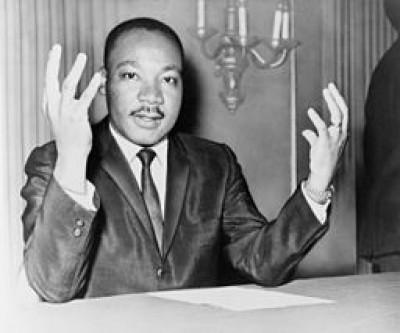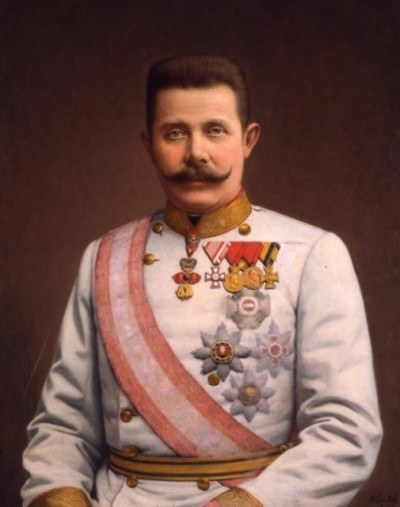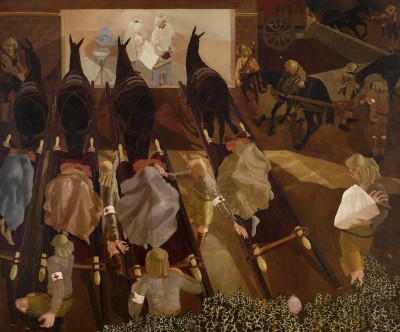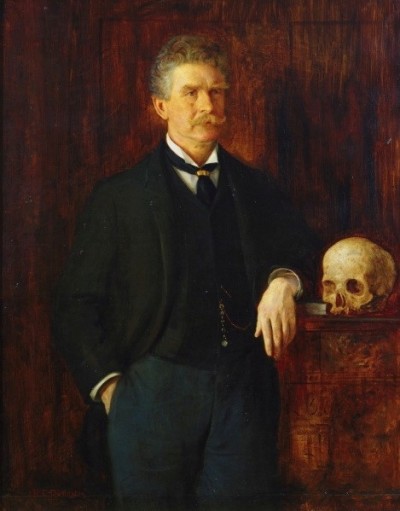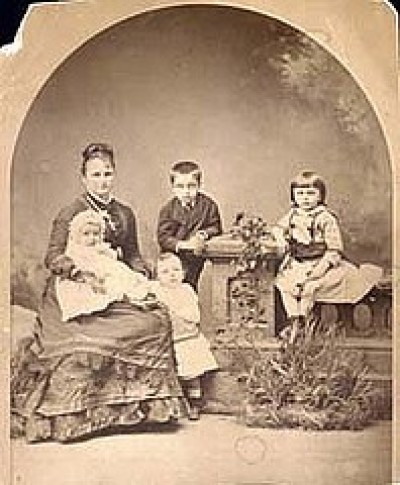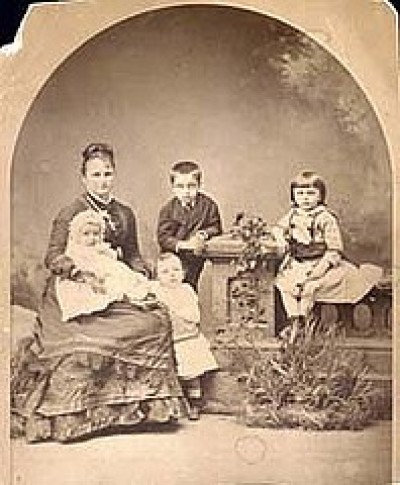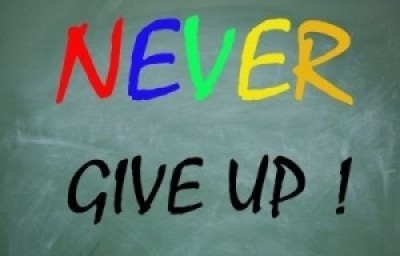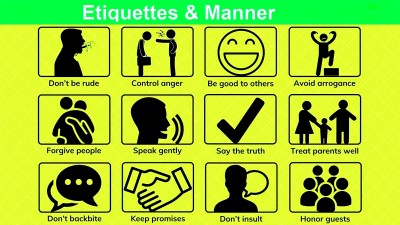Course description
The Long Struggle for Civil Rights in the US
In an earlier lecture, we looked at slavery and discussed its role in the southern states of America. The Civil War was fought over this issue but even when the Union forces won, in 1865, it did not mean that Afro-Americans had achieved equality. A century later, Martin Luther King, Jr., Malcolm X and many others, including Rosa Parks, were still fighting for their rights.
There was still segregation of blacks and whites in restaurants, dance halls, schools and universities. Martin Luther King and Malcolm X had very different approaches to how Afro-Americans might get their rights as citizens. This is their story.
Martin Luther King, Jr.
 Martin Luther King, Junior was born in the southern U.S.A. state of Georgia in 1929. He was a clever student at school and went to university. When he was a teenager, he was not sure about his Christian beliefs, but he later decided that the religion had many important truths. After completing a degree in sociology, he trained to become a man of religion, like his father. But he was also interested in the rights of Afro-Americans and how to make America a better place for black people to live and work.
Martin Luther King, Junior was born in the southern U.S.A. state of Georgia in 1929. He was a clever student at school and went to university. When he was a teenager, he was not sure about his Christian beliefs, but he later decided that the religion had many important truths. After completing a degree in sociology, he trained to become a man of religion, like his father. But he was also interested in the rights of Afro-Americans and how to make America a better place for black people to live and work.
 Although King understood that America must change, he could not find a way for this to happen until he heard about Mahatma Gandhi, the great Indian freedom fighter. After reading about Gandhi’s ideas on peaceful protest against British rule in India, King decided to use these to help Afro-Americans get their rights in the U.S. Like Gandhi, he believed that freedom and killing did not go together.
Although King understood that America must change, he could not find a way for this to happen until he heard about Mahatma Gandhi, the great Indian freedom fighter. After reading about Gandhi’s ideas on peaceful protest against British rule in India, King decided to use these to help Afro-Americans get their rights in the U.S. Like Gandhi, he believed that freedom and killing did not go together.
In 1955, King organized his first big protest in Montgomery, Alabama, another southern state in America. A black woman, called Rosa Parks, had worked all day at her job sewing. She sat down on the bus that was taking her home. In those days, black people sat at the back of the bus and whites at the front. When the bus got fuller, the blacks’ and whites’ seats met in the centre. If new white travelers got on the bus, black customers stood up. Rosa Parks refused. The police arrested her. You can read her story below.
Martin Luther King organized a boycott of the buses. In other words, no black person – and also some whites – got on a bus in the state. The police arrested King and people burnt down his home. There were more arrests too, but in December 1956 the U. S. Supreme Court decided that black people could sit where they liked on buses in Alabama. This may seem like a small change in the rights of Afro-Americans, but it wasn’t. Black people could now sit where they wanted in restaurants, parks, libraries, cinemas, theatres and churches. They could swim in the same pools as white people and sit on the beach with them too.
 King helped to make John F. Kennedy President of the United States, but later became unhappy about how slowly he was changing the law to help Afro-Americans. He organized new protests where black people broke unfair laws, although they did not fight. King understood that the newspapers and television were important in changing people’s ideas about the rights of black people. He was right. When the police in the southern states arrested hundreds and also used dogs against women and children, many more people began to ask for change in the country.
King helped to make John F. Kennedy President of the United States, but later became unhappy about how slowly he was changing the law to help Afro-Americans. He organized new protests where black people broke unfair laws, although they did not fight. King understood that the newspapers and television were important in changing people’s ideas about the rights of black people. He was right. When the police in the southern states arrested hundreds and also used dogs against women and children, many more people began to ask for change in the country.
But Kennedy and the F.B.I. were getting worried about King. They thought he was a Communist and started asking difficult questions about his past, his friends and his beliefs. They also looked at his friendships with women. King was married but always looked at beautiful women, and sometimes he did more than look.
 In 1963, King organized a march when President Kennedy began talking about changing the laws on equal rights in Washington. The police said he could not march in the capital, but King did not listen. In the end, more than 250,000 people of every colour went on the march and heard King’s famous ‘I have a dream’ speech. Here is part of it (changed a little to make it easier to read):
In 1963, King organized a march when President Kennedy began talking about changing the laws on equal rights in Washington. The police said he could not march in the capital, but King did not listen. In the end, more than 250,000 people of every colour went on the march and heard King’s famous ‘I have a dream’ speech. Here is part of it (changed a little to make it easier to read):
“I have a dream that one day on the red hills of Georgia the sons of slaves and the sons of slave owners will sit down together as brothers.
“I have a dream that one day even the state of Mississippi will be changed into an oasis of freedom and justice. I have a dream that my four little children will one day live in a country where their character will be more important than the colour of their skin. I have a dream that one day in Alabama, little black boys and black girls will join hands with little white boys and white girls as sisters and brothers. I have a dream today.”
The law changed so that black children could go to the same schools and universities as white children and that blacks and whites could work together in the same jobs for the same pay. King also wanted $2 an hour as a minimum wage. This was the first time that he looked at the economic rights of black workers. It was something that took more and more of King’s time and energy in the years before his murder in 1968.
Martin Luther King, Junior was shot outside his hotel room in April, 1968. His killer, James Earl Ray, always said that he was not working alone. Some people think the U.S. government helped him.
Today, Martin Luther King is one of the most famous Americans. He is the only one to have a U.S. national holiday in his name.
The woman who did not give her bus seat to a white man – Rosa Parks
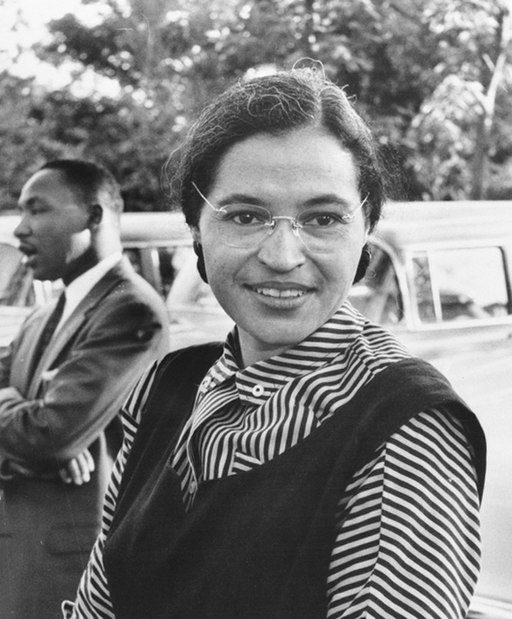 On 1st December, 1955, Rosa Parks was sitting on a bus on her way home from work. She was in the section for ‘coloured people’ or Afro-Americans. But the section for white people was full and the bus driver asked her to move so that the whites could sit down. There were three other Afro-Americans sitting in the same row as Parks. They stood up and walked to the back of the bus. Rosa Parks, a forty-two year old, married woman, refused. She was arrested and taken to the police station.
On 1st December, 1955, Rosa Parks was sitting on a bus on her way home from work. She was in the section for ‘coloured people’ or Afro-Americans. But the section for white people was full and the bus driver asked her to move so that the whites could sit down. There were three other Afro-Americans sitting in the same row as Parks. They stood up and walked to the back of the bus. Rosa Parks, a forty-two year old, married woman, refused. She was arrested and taken to the police station.
Rosa Parks had this to say about that day:
“People always say that I didn't give up my seat because I was tired, but that isn't true. I was not tired physically, or no more tired than I usually was at the end of a working day. I was not old, although some people have an image of me as old then. I was forty-two. No, the only tired I was, was tired of giving in.”
Rosa Parks was born in Montgomery, Alabama, in 1913. Her parents were divorced and she grew up with her grandparents. Decades later, she could still remember her grandfather standing behind his closed front door with a shotgun, when the Ku Klux Klan walked past their house.
She said about the buses in Montgomery:
 “I’d see the bus pass every day… But to me, that was a way of life; we had no choice… The bus was (one of) the first ways I realized there was a black world and a white world.”
“I’d see the bus pass every day… But to me, that was a way of life; we had no choice… The bus was (one of) the first ways I realized there was a black world and a white world.”
Many important civil rights leaders – Martin Luther King, for instance – were interested in Parks’ case. But it was taking a long time. It could take years. So, they decided they would do something different. They asked all Afro-Americans to boycott the bus service in Montgomery. They asked them to share cars and to take taxis – taxis asked for ten cents, the same as the bus fare to take Afro-Americans. They asked them to walk but not to get on a bus.
This boycott lasted 381 days. Many Montgomery buses stood in the bus station. The bus company had financial difficulties.
Finally, Montgomery changed its rules about black passengers giving their seats to white people more than a year after the boycott began. Parks won.
Rosa Parks worked for civil rights for Afro-Americans for the rest of her life. She never became rich because she gave the money from her books and talks to civil rights organisations. She died at the age of ninety-two in 2005.
Malcolm X
 Malcolm X was born Malcolm Little in 1925, and spent his teenage years moving from one foster home to another until he was sent to prison for theft, drug dealing and burglary when he was twenty-one. While he was behind bars though, he converted to Islam and educated himself, and, on leaving prison, became a spokesperson for the Afro-American Muslim group, Nation of Islam, headed by Elijah Muhammad.
Malcolm X was born Malcolm Little in 1925, and spent his teenage years moving from one foster home to another until he was sent to prison for theft, drug dealing and burglary when he was twenty-one. While he was behind bars though, he converted to Islam and educated himself, and, on leaving prison, became a spokesperson for the Afro-American Muslim group, Nation of Islam, headed by Elijah Muhammad.
Malcolm X was not in favour of peaceful protest or of integration with the white population. Instead, he wanted a separate state within the US for Afro-Americans before getting their own homeland in Africa. He argued that black people were the original race on the planet, that whites were “devils” and were soon to become extinct, as Afro-Americans were superior. He also believed that people had the right to use violence to defend themselves against attack or if there was no other way that they could win their rights. Malcolm X even spoke on the same stage as the leader of the American Nazi Party, George Rockwell, arguing that blacks and whites could never live in peace together.
 When President Kennedy was assassinated, Malcolm X disobeyed Elijah Muhammad, who ordered his group not to speak publicly on the death, and commented on television that he could not be sorry because Kennedy had deserved what he got. Of course, America was horrified and shocked.
When President Kennedy was assassinated, Malcolm X disobeyed Elijah Muhammad, who ordered his group not to speak publicly on the death, and commented on television that he could not be sorry because Kennedy had deserved what he got. Of course, America was horrified and shocked.
Yet, it was statements like these that made Malcolm X the darling of the media. He increased membership of the Nation of Islam from just 500 when he joined to many thousands, including the heavyweight boxing champion of the world, Mohammad Ali. But more than all that, he offered a voice to those Afro-Americans who were tired of waiting quietly for justice and of peaceful protest.
Malcolm X often criticized Martin Luther King and other civil rights leaders, calling them puppets of the white race. He called King’s March on Washington “the farce in Washington” and said he did not know why so many black people were excited about a demonstration "run by whites in front of a statue of a president (Lincoln) who has been dead for a hundred years and who didn't like us when he was alive". Malcolm X believed that fighting for civil rights was a mistake: Afro-Americans were battling for human rights and should take their case before the United Nations.
 Increasingly, Malcolm X turned his attention to developing nations – especially after he went on a pilgrimage to Mecca – and saw the Afro-American struggle as a global one. After he split with Nation of Islam leader, Elijah Muhammad, over differences of opinion on the Islamic faith, he became a Sunni, something his friends in the organization never forgave him for. Malcolm X started receiving death threats. Indeed, although his killers were never identified, many suspect that it was the Nation of Islam which ordered his assassination in 1965. Others blame the US government.
Increasingly, Malcolm X turned his attention to developing nations – especially after he went on a pilgrimage to Mecca – and saw the Afro-American struggle as a global one. After he split with Nation of Islam leader, Elijah Muhammad, over differences of opinion on the Islamic faith, he became a Sunni, something his friends in the organization never forgave him for. Malcolm X started receiving death threats. Indeed, although his killers were never identified, many suspect that it was the Nation of Islam which ordered his assassination in 1965. Others blame the US government.
We cannot be sure but there were signs that, in his last days, after meeting leaders like Nasser, the Egyptian leader, fighting for greater independence for Arabs, Malcolm X was starting to change his opinions about black supremacy and see the struggle for human rights for blacks as part of a wider, socialist movement.
But there was no time for Malcolm X to explain his new ideologies, as he was gunned down on stage when he was about to make a speech in February 1965, when he was just thirty-nine years old. He had a very different vision of the future for Afro-Americans than Martin Luther King and one which was continually evolving until the day he died.
If you want to watch some videos on this topic, you can click on the links to YouTube videos below.
If you want to answer questions on this article to test how much you understand, you can click on the green box: Finished Reading?
Videos :
1. Who was Martin Luther? 95 theses & the Reformation | World History (1517) (8:34)
2. The Life of Dr. Martin Luther King, Jr.- MLK Day! (Animated) Black History Month Video (9:37)
3. I have a Dream Speech by Martin Luther King. Jr HD (subtitled) (6:46)
4. Who was Malcolm X? (15:18)
5. Rosa Parks – Civil Rights Activist | Mini Bio| (4:40)
6. Gandhi- Human Rights Activist | Mini Bio| Biography (3:34)
7. John F. Kennedy : The 35th President of the United States | Biography (4:00)
8. What is the Ku Klux Klan? (3:14)

 Martin Luther King, Junior was born in the southern U.S.A. state of Georgia in 1929. He was a clever student at school and went to university. When he was a teenager, he was not sure about his Christian beliefs, but he later decided that the religion had many important truths. After completing a degree in
Martin Luther King, Junior was born in the southern U.S.A. state of Georgia in 1929. He was a clever student at school and went to university. When he was a teenager, he was not sure about his Christian beliefs, but he later decided that the religion had many important truths. After completing a degree in Although King understood that America must change, he could not find a way for this to happen until he heard about Mahatma Gandhi, the great Indian freedom fighter. After reading about Gandhi’s ideas on peaceful protest against British rule in India, King decided to use these to help Afro-Americans get their rights in the U.S. Like Gandhi, he believed that freedom and killing did not
Although King understood that America must change, he could not find a way for this to happen until he heard about Mahatma Gandhi, the great Indian freedom fighter. After reading about Gandhi’s ideas on peaceful protest against British rule in India, King decided to use these to help Afro-Americans get their rights in the U.S. Like Gandhi, he believed that freedom and killing did not  King helped to make John F. Kennedy President of the United States, but later became unhappy about how slowly he was changing the law to help Afro-Americans. He organized new protests where black people broke unfair laws, although they did not fight. King understood that the newspapers and television were important in changing people’s ideas about the rights of black people. He was right. When the police in the southern states arrested hundreds and also used dogs against women and children, many more people began to ask for change in the country.
King helped to make John F. Kennedy President of the United States, but later became unhappy about how slowly he was changing the law to help Afro-Americans. He organized new protests where black people broke unfair laws, although they did not fight. King understood that the newspapers and television were important in changing people’s ideas about the rights of black people. He was right. When the police in the southern states arrested hundreds and also used dogs against women and children, many more people began to ask for change in the country. In 1963, King organized a march when President Kennedy began talking about changing the laws on equal rights in Washington. The police said he could not march in the capital, but King did not listen. In the end, more than 250,000 people of every colour went on the march and heard King’s famous ‘I have a dream’ speech. Here is part of it (changed a little to make it easier to read):
In 1963, King organized a march when President Kennedy began talking about changing the laws on equal rights in Washington. The police said he could not march in the capital, but King did not listen. In the end, more than 250,000 people of every colour went on the march and heard King’s famous ‘I have a dream’ speech. Here is part of it (changed a little to make it easier to read): On 1st December, 1955, Rosa Parks was sitting on a bus on her way home from work. She was in the section for ‘coloured people’ or Afro-Americans. But the section for white people was full and the bus driver asked her to move so that the whites could sit down. There were three other Afro-Americans sitting in the same
On 1st December, 1955, Rosa Parks was sitting on a bus on her way home from work. She was in the section for ‘coloured people’ or Afro-Americans. But the section for white people was full and the bus driver asked her to move so that the whites could sit down. There were three other Afro-Americans sitting in the same “I’d see the bus pass every day… But to me, that was a way of life; we had no choice… The bus was (one of) the first ways I realized there was a black world and a white world.”
“I’d see the bus pass every day… But to me, that was a way of life; we had no choice… The bus was (one of) the first ways I realized there was a black world and a white world.” Malcolm X was born Malcolm Little in 1925, and spent his teenage years moving from one
Malcolm X was born Malcolm Little in 1925, and spent his teenage years moving from one When President Kennedy was
When President Kennedy was
